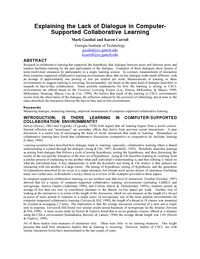Explaining the lack of dialogue in computer-supported collaborative learningMark Guzdial, Karen Carroll
Zu finden in: CSCL 2, 2002
 |
 |
 Diese Seite wurde seit 6 Jahren inhaltlich nicht mehr aktualisiert. Unter Umständen ist sie nicht mehr aktuell.
Diese Seite wurde seit 6 Jahren inhaltlich nicht mehr aktualisiert. Unter Umständen ist sie nicht mehr aktuell. Zusammenfassungen
Zusammenfassungen
 Research in collaborative learning has supported the hypothesis that dialogue between peers and between peers and teachers facilitates learning by the peer participants in the dialogue. Examples of these dialogues show dozens of turns (individual utterances by participants) in a single learning session. In contrast, measurements of interaction from computer-supported collaborative learning environments show that on-line dialogue looks much different, with an average of approximately one posting or less per student per week. Measurements of learning in these environments do suggest learning is occurring, but presumably, not based on the same kind of dialogue described in research on face-to-face collaboration. Some possible explanations for how the learning is arising in CSCL environments are offered based on the Vicarious Learning Project (Lee, Dineen, McKendree, & Mayes, 1999; McKendree, Stenning, Mayes, Lee, & Cox, 1998). We believe that much of the learning in CSCL environments occurs from the observation of the dialogue, the reflection induced by the potential of submitting, and at least in the cases described, the interaction between the face-to-face and on-line environments.
Research in collaborative learning has supported the hypothesis that dialogue between peers and between peers and teachers facilitates learning by the peer participants in the dialogue. Examples of these dialogues show dozens of turns (individual utterances by participants) in a single learning session. In contrast, measurements of interaction from computer-supported collaborative learning environments show that on-line dialogue looks much different, with an average of approximately one posting or less per student per week. Measurements of learning in these environments do suggest learning is occurring, but presumably, not based on the same kind of dialogue described in research on face-to-face collaboration. Some possible explanations for how the learning is arising in CSCL environments are offered based on the Vicarious Learning Project (Lee, Dineen, McKendree, & Mayes, 1999; McKendree, Stenning, Mayes, Lee, & Cox, 1998). We believe that much of the learning in CSCL environments occurs from the observation of the dialogue, the reflection induced by the potential of submitting, and at least in the cases described, the interaction between the face-to-face and on-line environments. Dieser Text erwähnt ...
Dieser Text erwähnt ...
 Personen KB IB clear | Karen Carroll, Mark Guzdial, Lissa Holloway-Attaway, Jochen Rick, Lew Semjonowitsch Vygotsky, Brandy Walker | |||||||||||||||||||||||||||
 Begriffe KB IB clear | CSCLComputer-Supported Collaborative Learning,  Lernen Lernen learning learning | |||||||||||||||||||||||||||
 Bücher |
| |||||||||||||||||||||||||||
 Texte |
|
 Tagcloud
Tagcloud
 Zitationsgraph
Zitationsgraph
 1 Erwähnungen
1 Erwähnungen 
- Computer Support for Collaborative Learning - Foundations for a CSCL Community - Proceedings of CSCL 2002 (Gerry Stahl) (2002)

- Collaborative Learning at Low Cost - CoWeb Use in English Composition (Jochen Rick, Mark Guzdial, Karen Carroll, Lissa Holloway-Attaway, Brandy Walker)

- Collaborative Learning at Low Cost - CoWeb Use in English Composition (Jochen Rick, Mark Guzdial, Karen Carroll, Lissa Holloway-Attaway, Brandy Walker)
 Volltext dieses Dokuments
Volltext dieses Dokuments
 |  Explaining the lack of dialogue in computer-supported collaborative learning: Artikel als Volltext ( Explaining the lack of dialogue in computer-supported collaborative learning: Artikel als Volltext ( : :  , 71 kByte; , 71 kByte;  : :  Link unterbrochen? Letzte Überprüfung: 2021-03-21 Letzte erfolgreiche Überprüfung: 2006-07-20) Link unterbrochen? Letzte Überprüfung: 2021-03-21 Letzte erfolgreiche Überprüfung: 2006-07-20) |
 Anderswo suchen
Anderswo suchen 
 Beat und dieser Text
Beat und dieser Text
Beat war Co-Leiter des ICT-Kompetenzzentrums TOP während er Dieser Text ins Biblionetz aufgenommen hat. Die bisher letzte Bearbeitung erfolgte während seiner Zeit am Institut für Medien und Schule. Beat besitzt kein physisches, aber ein digitales Exemplar. Eine digitale Version ist auf dem Internet verfügbar (s.o.). Aufgrund der wenigen Einträge im Biblionetz scheint er es nicht wirklich gelesen zu haben. Es gibt bisher auch nur wenige Objekte im Biblionetz, die dieses Werk zitieren.











 Biblionetz-History
Biblionetz-History